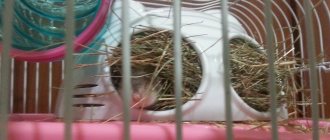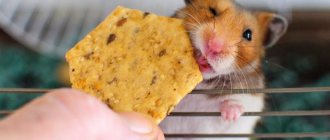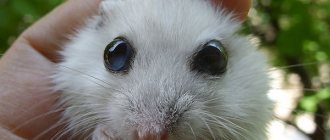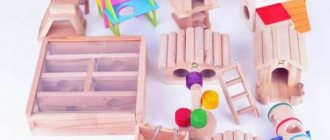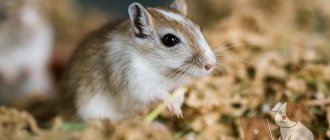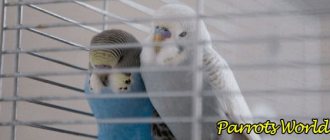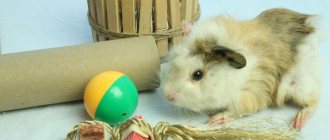Hamsters are small rodents that are well adapted to home conditions. There are several types. The most common ones include dzhungarik. These are small animals with a body length of 10-12 cm. Another species is the Syrian rodents with a pleasant golden skin. They are classified as large representatives of the species.
Hamsters are surprisingly nimble animals. At home, they either sleep in their cozy cage or quickly move around the room. In the wild, they are known to cover up to ten kilometers a day. Knowing about this feature, kind owners let the little animals out to walk around the house. However, this activity is unsafe, because hamsters are capable of chewing through furniture, hiding in a corner, etc. You may not notice a rodent on the floor and accidentally step on it, so it will be better if the owner purchases a special ball for the hamster.
What is a hamster ball?
Criterias of choice
But in order to protect your pet from possible injury, you need to know several important rules for choosing this sports accessory.
Main size
Choosing the optimal size is the main condition for purchasing a ball that is safe for the health of your hamster.
Balls for rodents are divided into several types:
- 12-13 cm;
- 18-20 cm;
- 28-33 cm.
For larger species, such as the Syrian hamster, a medium-sized sphere (18-20 cm in diameter) would be an ideal option, but for large rodents (common hamster, etc.) the largest possible sphere with a diameter of 28 cm or more is best. cm.
The area for walking should be chosen strictly according to the size of the animal. The angle of the animal’s back depends on the size of the walking device, which is the main condition for its safe operation.
In a ball of the correct size, it should be almost even. If you choose an excessively small sphere, then due to lack of free space the animal's back will be strongly concave inward.
It will also be useful for you to learn how to choose a cage for a hamster, what hamsters eat, how long hamsters live at home, and how to train a hamster to respond to its name.
In this case, his body will throw from side to side when moving, and this will only worsen the quality of the walk and can lead to damage to the baby’s delicate paws.
Important! The diameter of an ideal walking sphere should be several centimeters larger than the length of the pet’s body.
Is color important?
In most cases, hamsters use their sense of smell when moving. In these animals, the organs of vision are not as developed as in humans, so their eyes can only distinguish the outlines of objects. The same applies to color perception.
The ideal color scheme for a hamster would be a transparent, colorless walking ball. It will provide the necessary overview, as well as access to a sufficient amount of light
But if you couldn’t find it in your pet store, pay attention to devices made of plastic with a green or yellow tint.
The amount of light transmitted by them will be slightly lower, but these shades will help the animal increase the contrast of surrounding obstacles.
Do you need fastening?
As mentioned above, the mount for the walking ball is an additional accessory; its task is to secure the device in one plane.
For the most part, additional fastenings are useless, since each rodent cage is equipped with a sports wheel that operates on the same principle.
Did you know? Hamsters are one of the few mammals that are born with teeth, and their growth increases throughout their lives.
However, sometimes it is necessary. Daily walks often bring a lot of discomfort, especially when guests arrive, since the animal can be accidentally injured by a person.
How to place an order?
It is very easy to purchase a hamster wheel in our online store. You just need to select the appropriate product and add it to your cart, which can be done with or without registration.
If you cannot find an answer to your questions, then calling our managers, who work daily from 9-00 to 21-00, will allow you to quickly find out the answers to your questions and place an order for the hamster wheel you like.
In our store you can purchase this product from manufacturers such as Triol.
Description and purpose
The hamster ball is a transparent plastic sphere with a small door. It is equipped with several ventilation holes so that your hamster can breathe properly.
This is not just a fashion accessory. The ball is needed so that the animal can move freely around the apartment. Without it, the baby can easily get lost, get stuck in a gap, or chew something.
In addition, a person, without noticing a small rodent running freely around the room, may accidentally injure it
The ball also allows the hamster to periodically change its environment, which is important for its psychological state.
Varieties of balls for walking on sale
You can find many models of walking balls on sale, but they can all be divided into three types:
- simple,
- with the trajectory of movement,
- with stand (2 in 1).
The first option is a simple smooth transparent plastic ball. Models of the second type are equipped with special grooves that allow the hamster to follow a certain trajectory while running. This option is also convenient for the owner - it makes it easier to keep the hamster in sight. Some models come with special stands that allow you to secure the ball in a certain position. In this case, the walking ball is transformed into a sports wheel for running.
Price
The cost of a walking ball depends on its size, configuration, as well as the brand that produces the product. On average, spheres cost from 200 to 800 rubles. The simplest model of the smallest diameter can be purchased for 200-250 rubles. A more functional ball with a stand costs more. For example, you can find models whose price exceeds 1,500 rubles.
What price do you think is appropriate for such an accessory? Poll Options are limited because JavaScript is disabled in your browser.
How to choose the right ball for a hamster
The dimensions of the device are selected depending on the breed of the pet: a Syrian hamster needs a larger ball, a Djungarian hamster needs a small one. You can buy a walking ball of different diameters. They are:
- 13 cm – sphere for a small Djungarian hamster;
- 18 cm – universal ball size, suitable for any breed;
- 29 and 33 cm are large balls, ideal for a Syrian hamster.
Size is of considerable importance, since if the diameter of the ball is too small for the hamster, the animal will run and arch its back. But you don’t need one that’s too big either, since a small animal will fall from side to side and hit the walls.
This accessory is available in the market in different models. They are basically hollow spheres that move easily in any direction. You can buy models that have a track that sets the direction of movement. This is actually very convenient, because in this case the animal will move along a given route and will not disappear from sight. A walk in such an area is an excellent option that will solve the problem of the animal’s motor activity, and besides, this device has a budget price, which cannot but please the owner.
The cost of the sphere actually varies and depends on the model. It is recommended to choose a model that is as transparent as possible with many holes for ventilation. The color of the ball is a personal matter for everyone. Popular are colorless transparent models that allow the hamster to see the surroundings while running.
Flaws
While walking, the hamster sometimes goes to the toilet. Feces fly out of the vents and scatter throughout the house. After your walk, you should follow the trail of the animal and clean up.
Door fasteners wear out over time. There is a risk of the ball breaking while walking. If the product falls apart, the hamster will run away.
Choose a ball with as many holes as possible for ventilation, otherwise your hamster may suffocate. During the walk, which should last no more than 20 minutes, the temperature inside the sphere increases and the amount of oxygen decreases. If the animal spends more than a few hours in “captivity”, it may die from lack of oxygen, overheating, thirst or hunger.
Pros and cons of a hamster ball
This accessory has a number of advantages:
- the animal is safe, it will not get lost or fall;
- the hamster will not spoil things in the apartment;
- the hamster will be delighted with a long walk.
Not all owners of these cute rodents know how to train the animal to walk in the sphere, but if this works, the pet will be very grateful to the owner.
In any case, it is better not to leave the hamster in the ball for a long time for safety reasons.
The main advantage of a walking ball is that your little pet will be able to walk freely and for a long time around the apartment without causing damage to it. The cost of the ball is low. For just 200 rubles you can freely purchase this useful gadget for your pet.
It is important to know that walking spheres are presented on the market in a huge assortment, but when choosing, you need to look for the one with the most holes for air exchange
Of course, the ball also has its disadvantages
When purchasing it, you need to make sure that it has good ventilation. The hamster should stay in it for no more than 20 minutes, otherwise he may simply not have enough air and die
While running, the sphere heats up, and even despite the large number of holes, little air enters it. Hamsters often left in a ball for a long time eventually died. This mainly happened due to lack of air. But this can also happen because the hamster simply wants to eat or drink, but cannot get out of the ball on its own.
It is necessary to remember that when walking in a ball, the hamster relieves its physiological needs right inside and when running, all this scatters around the room. And one more important thing: with constant use of the fastening, the doors become unusable and one day they may fall apart during a walk and release the hamster.
Advantages
One of the advantages of the product is safety. The hamster ball protects the animal from injuries, wounds, and falls. The rodent will not get lost in a spacious home and will not be able to climb into narrow places inaccessible to the owner. Such a walk is also safe for an apartment. The hamster will not chew through wires and things, and will not drag small objects into the corner.
Expanding your horizons is also a plus for exploring areas. Hamsters are curious, agile creatures that strive to explore the most hidden places of their cages and apartments. A circle for a hamster makes it possible to examine the territory of interest to the animal without additional threats. You should warn everyone who is in the apartment about your pet's walk, so as not to accidentally crush the device.
It is more difficult to control a ball than a wheel, so the animal will fall asleep faster after a walk. At night he will cause less trouble, make less sounds and be less active.
A hamster in a walking ball is able to explore the entire apartment without causing inconvenience to the owner. Shared housing is an extremely interesting object for a hamster. Do not deprive your animal of the opportunity to walk outside your house.
Before purchasing an accessory, pay attention to the number of ventilation holes. Choose a circle with the largest number of holes so that your pet can breathe freely.
Hamster care
Keeping and caring for a hamster at home is a simple process, but it requires certain knowledge and care. You can determine whether your animal is feeling well by such signs as shiny fur without bald spots, a clean nose and eyes, even breathing, and the absence of digestive disorders. Since the pet usually sleeps most of the day, it is better to assess its behavior in the late afternoon, during the period of activity.
Cage for a hamster
Caring for and keeping a hamster at home always starts with choosing a good cage. They come in plastic and lattice. Plastic container-like ones are most convenient for dwarf hamsters (Roborovsky, Campbell, and dwarf hamsters). But lattice ones are perfect for golden (or Syrian) breeds. The main thing is that the bars of the cage are placed horizontally so that the animal can climb the walls. The gap between the rods also depends on the specific type - for golden, a distance of 1 centimeter is acceptable, for smaller types - less.
If the distance between the bars of the cage is incorrect, the animal may unsuccessfully stick its head between them and die from suffocation.
The next step in caring for an animal at home is to properly equip its “apartment”. It starts with the choice of bedding - both the comfort of the rodent and the time you will spend cleaning the cage will depend on this. It is advisable not to use newsprint as bedding, otherwise your pet may be poisoned by printing toner. In addition, such paper does not absorb liquids and odors well. However, the same applies to ordinary paper or cotton wool. Cotton wool in a cage is also not recommended because the animal's small paws can get tangled in it.
Fillers such as sawdust, hay or wood shavings are better suited. But some animals are allergic to ready-made wooden pellets. Corn (chopped cobs with a few grains left) is recognized as the best option for filling the cage. It is very light and pleasant for the animal. This filler is more expensive than others, but it retains the smell for up to ten days.
Place two feeders in the cage - one will serve for soft food such as fruit, the other for hard and dry food. And for water it is better to purchase a special drinking bowl, changing the contents every day.
Hamster wheel
Caring for a hamster at home is not complete without providing it with physical activity. To do this, you need to equip the cage with a wheel, and also buy a hamster ball and other accessories (slides, ladders). The wheel must be solid, with transverse protrusions. Then it will be convenient for the animal to place its paws on it.
The rodent will use all this variety in the cage mainly at night, and during the day it will rest in its burrow. A special house can serve as a mink, but sometimes the animal prefers to make its own home by collecting filler or bedding to the side.
Hamster ball
It is worth talking in more detail about such a device as a hamster ball. This is an excellent simulator that will not let the animal get bored. Ready-made balls are sold in stores, or you can make the device yourself. Its purpose is to allow the animal to move freely around the apartment without the risk of being crushed, caught by a cat, or stuck somewhere. A hamster ball will fit especially well in a large apartment or house.
The easiest way to make this accessory is from an ordinary plastic bottle. Due to its lightness, it will not make it difficult for the hamster to move. In addition, you can make holes in it for ventilation. Actually, no other manipulations are required - the hamster ball is ready for use.
You can also take not a bottle, but a plastic ice cream bucket (the main thing is that it is transparent). The bucket must be thoroughly washed and dried, and then small holes must be made in the bottom or lid of the container. Now you can put the hamster inside and close the lid. In a similar way, you can make a ball for a hamster from any container. The stores sell dozens of different beautiful and convenient options.
How to make a simulator with your own hands
Pet rats - description, care, pros and cons of a pet
When buying a walking ball, you can make a number of mistakes. Often the size of the toy is not suitable for hamsters, he feels discomfort and is afraid to come closer to it. To prevent this from happening, owners are advised to first make the walking sphere with their own hands. This is not difficult to do; even teenagers will be happy to get to work.
DIY walking ball for dzhungarika
To create a simulator you will need:
- a round plastic container, the diameter of which should start from 12 cm for dzhungarikas and higher for other rodents:
- sharp stationery knife;
- awl;
- sandpaper;
- hand or dishwashing detergent.
For the ball itself, choose a milk or water container. It is important that its lid is wide enough to serve as an entrance for the pet. After preparing all the tools, you must thoroughly rinse the container, remove all stickers from the container, remove any remaining glue and allow to dry.
Note! Containers containing toxic materials should not be used as a walking ball. Even thorough washing will not remove the remaining poison; animals may die in them.
Then, using an awl, you need to make small holes for air. Use a utility knife to cut holes through which the hamsters could not only breathe oxygen, but also cling with their paws. The size of the holes is 0.3x4 cm. At the very end, all that remains is to sand all the holes with sandpaper. The ball for the walk is ready.
Another important rule: since the holes in the ball themselves are small, the pet cannot stay in it for more than 20 minutes. This limitation must be remembered all the time, otherwise the animals will experience oxygen starvation.
Types of running wheels for hamsters
Hamsters of different breeds can be very tiny, from 4.5 cm to large individuals reaching 34 cm in length. Accordingly, some are lighter, others are heavier. Depending on the type of your hamster, you should select a running wheel for your pet.
Which wheel you choose for your hamster’s home will depend not only on its health, but also on its safety. Agree, if you buy a small wheel for a large hamster, and a huge one for a miniature one, then your animals will not be able to run on this simulator.
So the first thing you need to do is decide on the diameter of the running wheel.
For example, for Djungarian hamsters or for a Syrian baby, the diameter of the wheel should be a minimum of 14 cm and a maximum of 16 cm.
An adult Syrian hamster needs wheels more than 18 cm in diameter.
The track in the wheel must be of sufficient width. If its width is not enough, the hamster may fly out of the wheel. For example, for miniature dwarf breeds, a width of 5 cm will be enough, but for Syrian hamsters, the width of the wheel should be at least 7 cm.
The trainer should be the size of your rodent. If you have not chosen the correct diameter of the treadmill, then your baby will squeeze, stumble and get injured in the small wheel. It's hard for kids to run in a wheel that's too big. They have difficulty rotating it and, as a result, will stop using it altogether.
Not only the comfort of your hamster, but also the health of your pet depends on a correctly selected wheel. The consequences of incorrectly purchased running wheels can be sad. Spinal injuries, dislocations of limbs and even fractures are possible.
Running wheels are:
- plastic;
- metal;
- wooden;
- combined.
One of the disadvantages of metal running wheels is that they tend to squeak over time. Considering that your animal loves a nocturnal lifestyle, it will train in its wheel at night. Your sleep and a squeaky wheel don't go well together, would you agree?
The plastic running wheel is quiet and comfortable enough for a hamster to run. The main thing is that the treadmill has small ribs that the little athlete can cling to and not slip off.
Running wheels made from a combination of plastic and metal materials have proven themselves. The wheel itself is made of plastic, and the stand is metal. This is a silent and lightweight design with a reliable metal support.
Basically, lattice, mesh and wooden running toys for hamsters are common. If the wheel has a metal mesh, then the cells should be small so that the furry paws do not fall into them.
Important! The gap between the rotating working part of the surface of the simulator and the fastening of the wheel stand axle must be more than one centimeter. Otherwise, the hamster risks cutting off its leg, as the limb may get stuck in a narrow space, in which case the “scissors effect” is obtained.
The only negative is that from time to time the hamster can sharpen its teeth on its treadmill, but this will not cause any harm to its health.
Methods for attaching running wheels
- Hinged - screwed with special fasteners or ordinary wire to the cage lattice. This option is suitable for small cells. During hamster training, there may be sounds of the wheel tapping on the mesh of your pet's home.
- Floor-standing - these wheels stand on a floor stand and fit well into a spacious cage. The main disadvantage is that they are not entirely stable.
- On a stand with floor mounting - this method of mounting is more reliable. The stand attaches securely to the cage floor. This is the safest simulator.
Necessary purchases for meeting a hamster
The main list with important attributes for keeping a dzhungarika or Syrian hamster fits into several items. So, before your pet arrives at home, you need to prepare:
- cell;
- drinking bowl;
- feeder;
- filler;
- wheel;
- house.
When buying a cage for a hamster, it is important to take into account the size of the pet, choosing the optimal space for the future home. Do not forget that it is also necessary to place useful accessories for your pet in it - a running wheel and a cozy house in which the hamster will sleep with pleasure
Don't forget that you also need to place useful accessories for your pet in it - a running wheel and a cozy house in which the hamster will sleep with pleasure.
You shouldn’t neglect buying a wheel to save space, since a treadmill is the key to your pet’s health. Living in nature, rodents are able to run more than 20 km every day in search of food, which allows them to maintain good physical shape and strong immunity. At home, left without the opportunity to actively move, rodents can become depressed or simply gain weight, which will negatively affect their health.
A small wooden house inside the cage will replace the animal’s usual hole, in which you can hide from bright light and relax peacefully. Often hamsters use such houses as a pantry, making edible supplies. Therefore, the accessory needs to be cleaned 1 to 2 times a week, periodically removing any remaining food from it. This is especially true for fresh foods that rodents feast on: pieces of bananas, cheese or meat. Regular cleaning will protect the animal from possible food poisoning, which can lead to dire consequences.
As a filler for the cage, you can use ordinary straw or its compressed analogues, which can be easily purchased at any veterinary store.
What should be in the hamster's cage, in addition to the filler, are paper napkins or other soft-textured paper. With their help, the animal will build cozy nests for breeding offspring, and also use them as a toilet. By filling a certain corner of the cage with napkins, you can accustom the rodent to the sanitary area, which will greatly facilitate the task of cleaning its territory in the future.
Choosing a ball without fasteners and with a stand
In most cases, the ball is chosen to be round, but oval is also found. The latter is not so preferable, as your furry friend may lose his balance.
Sold without mounts, but also available with a stand. The most common model is with a square leg. A more original version is in the shape of a globe.
This is a modified version of the running wheel. The hamster runs around in it, while remaining in place. But the owners have the opportunity to unfasten the ball and let the pet out for a walk.
A ball on a stand is the most convenient option
When purchasing, pay attention to the following details:
Transparency
You can choose the color at your discretion, but it is important that the design itself is as transparent as possible. The animal may not notice the furniture during walks, which will lead to damage to the ball
It's best to go with the colorless option. Ventilation holes. While running, the hamster spends a lot of energy, which leads to active absorption of oxygen. As a result, carbon dioxide is released in large volumes, and the rodent may experience attacks of suffocation. The ball should have as many ventilation holes as possible over its entire surface. Reliability of fastenings. Typically there is one door in the design, but there can be up to four. All of them must be securely closed with lids. If this is not observed, then the owners can quickly lose their furry friend from their field of vision. Design safety. The material from which the structure is made is important. Most often it is non-toxic plastic. The buyer has the right to request a quality certificate.
Good ventilation for a hamster is a guarantee of traveling in comfort
Table 1. Balls for different breeds of hamsters.
| Breed | Ball diameter |
| Dzungarian, Sungur, Chinese, Campbell's, Roborovsky's hamster | 12-13 cm |
| Syriac, Angora | 18-20 cm |
| Ordinary | 28-33 cm |
A ball without fastenings or on a stand is everyone’s business. The second option is more convenient in terms of storage, but it is also more expensive.
How much does the toy cost?
Prices for exercise equipment such as the hamster wheel vary widely. There is a direct relationship between the size and cost of such products: the larger it is, the higher the price. The material also has an impact. A metal wheel is more reliable, since even high-quality plastic can be chewed by a hamster, but it is quite noisy and often has too large a distance between the rods. Experts recommend giving preference to plastic products in the mid-price range, which are presented on our website, since they are quite reliable, safe, and easy to maintain.
Features of use
Despite the fact that this rodent walking device is quite easy to use, many hamster owners make serious mistakes in using it.
This can end badly for the health of the hamster and the emotional state of its owner. Therefore, next we will consider the basic principles of its safe use.
As a pet rodent, you can also choose a jerboa, guinea pig, ornamental rat, gerbil, dormouse, squirrel, chipmunk, degu.
How to use a walking ball correctly
The first thing you should do after purchasing a walking sphere is to gradually accustom your pet to it. Most rodents are quite timid animals, so having a hamster in a new space can be quite stressful for him.
Every day the time the hamster stays in the ball should be increased, until it is completely mastered in new conditions. To interest the rodent before each walk, you can place a small piece of fruit or vegetable inside the device.
In the first days, you should help the hamster master the basic principles of movement in the sphere. To do this, the ball must be gently pushed or rolled from side to side. In most cases, the rodent fully understands the new entertainment within a few days.
Important! If the hamster does not show sufficient interest in free walks, it should not be forced, as this will cause additional stress in the animal. When the animal is completely comfortable, you can begin daily walks.
Walking can be done in several ways:
- free;
- on a certain perimeter;
- along specially constructed tracks.
The safest are walks along a given route; for these purposes, special routes with low sides, closed in a ring, are created. However, not everyone can afford such an accessory.
Such routes require the availability of a sufficient amount of free space, as well as the expenditure of additional funds on their arrangement.
Suddenly the hamster may roll out from around the corner at the feet of the owner or the rest of the family, in which case injury to the animal cannot be avoided. The duration of daily walks is individual for each individual, but in most cases, hamsters are walked no more than 30-60 minutes a day.
Precautionary measures
Basic safety measures when walking a hamster in an outdoor area:
- the door of the device must be tightly closed, otherwise the rodent may escape;
- Walking should be carried out on a flat and uniform surface, away from stairs and other changes in height;
- walking on a table, windowsill, etc. without a special stand is strictly prohibited;
- if there is a cat, dog or other large animal in the apartment, they must be taken to a separate room;
- the hamster must move independently, without external assistance, otherwise this can lead to serious injuries to the animal;
- only one animal can walk in one sphere;
- It is not recommended to place any objects inside the sphere;
- it is strictly forbidden to wrap the walking ball in polyethylene or cover the ventilation holes, otherwise the rodent may develop hypoxia;
- After each walk, the sphere should be washed with detergents and dried.
Important! All family members should know about the hamster's walk, especially if there are small children among the household members
Precautionary measures
To make your walks safe, you must take precautions.
- The door must be well closed. If it becomes loose and opens spontaneously, this ball should no longer be used.
- There is no need to wrap the surface of the ball with tape for reliability. This can block the ventilation holes and the hamster will suffocate.
- The hamster should walk on a flat surface. Access to stairs and other height differences must be blocked.
- Do not let your hamster roam on tables, windowsills or other high surfaces from which he could fall onto the floor. Or use special barriers.
- There should be no cats, dogs or other large animals in the room where the rodent runs. Even if they don't touch the hamster, the pet will experience stress.
- There can only be one animal in one ball.
- Do not place foreign objects into the sphere.
And don't forget about cleanliness. After each walk, the accessory must be washed and dried well.
What is the difference between the white Syrian hamster and the rest?
The white Syrian hamster has no fundamental differences from Syrian hamsters of other colors. At the same time, white coat color is less common than others. White hamsters have all the characteristics of albino animals, such as red eyes. This makes it easy to distinguish it from rodents with cream fur and ordinary gray eyes.
In fact, all care for hamsters comes down to feeding, adding water to the drinking bowl and cleaning the cage (2-3 times a week). The cage should be lined with a thick layer of sawdust, equipped with a wheel, drinking bowl and feeder. Every day, new water is added to the animal and food is given (preferably at the same time). Woolen threads, cotton wool and straw should not be used as bedding for the cage.
The hamster must be periodically released from the cage to walk around the apartment. It is advisable to teach him from childhood not to be afraid of human hands and presence. Having become accustomed to its owner, the Syrian hamster remains tame and docile throughout its life.
The favorite food of Syrian hamsters is boiled cereals, milk, pasta and wheat bread. A complete diet for a hamster is impossible without vitamin supplements and boiled meat.
In this regard, domesticated hamsters, which to this day have partially retained the habits of their ancestors, are kept alone, with the exception of cases when the female is briefly allowed into the male’s cage for reproduction. If you let a male into a female’s cage, the female partner is unlikely to show him favor. At such moments, you need to look after your pets in order to have time to break up their fight, the likelihood of which remains in any case.
Wild Djungarian hamsters live in families, which means it is permissible to keep several hamsters in one cage. It is advisable to keep them in pairs, seeding the grown-up cubs. The spaces between the bars of the cage should be narrow so that small hamsters cannot escape. Djungarian hamsters need to be handled and fed every day, otherwise the rodent will no longer recognize the owner and will again become wild and nervous.
Syrian and Djungarian hamsters are white
How to teach your baby to take active walks
Monitor your pet's behavior. If the animal does not like this kind of entertainment, do not force it to walk in the ball. Stress will negatively affect the hamster's condition and a walk will not be beneficial.
To interest the animal, place a treat in the circle for the hamster - an apple or other fruit. The animal will reach into the ball to pick up the treat. Now rotate the sphere a little so that the rodent understands the “principle of operation” of the device. Noise, loud sounds and sudden movements will negatively affect learning. Patiently teach your rodent how to use a new toy until he begins to take walks on his own.
Do not forget to monitor the time the animal remains in the ball. Stop the fun in time.
Principles of use:
- Carefully place your pet into the device and close the door tightly.
- Lower the animal to the floor. Do not leave the ball on a table or other high objects. A fall will have a negative impact on the baby.
- Protect ledges and stairs from which the ball could roll.
- Limit other pets' access to the hamster's "running area". The toy will interest the animals and they will start playing with it. This will create stress for the rodent. He may get injured.
- Don't push the sphere. Khoma must drive his “transport” independently.
- Do not put several individuals in one ball.
https://youtube.com/watch?v=UK5-ZNbPvZY
What is the ball for?
Labyrinths and wheels do not compensate for the animal's need for movement. A walking ball is necessary for the rodent to expend the required amount of energy and not get bored. Such an accessory makes walking around the apartment safe, since the hamster will not get lost or climb into hard-to-reach places.
The accessory is easy to use: place the pet in the ball and close the door. The rodent itself sets the structure in motion. The hamster runs, the sphere rolls.
In appearance, the product is quite simple, a completely or partially transparent ball with a circle-shaped inlet. The entrance is closed with a round door. The sphere is made of plastic.
Games in the cage
If there are other pets at home or you are worried about the safety of your home, you can diversify your pet’s leisure time with the help of special devices. Play complexes of different sizes and variations can be purchased at many pet stores or you can build them yourself.
Swing
By placing a plank on a round block, you can build a rocking chair. So that the hamster understands what needs to be done, place a treat on the opposite side. After a while, the animal will learn to balance and will have fun.
Football with a hamster
To assemble an improvised football field, just glue the cardboard into the shape of an ordinary box and cut a round hole (the size of a glass) on one side of the box. A glass with a cut out bottom is inserted into the prepared hole and secured with a glue gun. It will serve as the entrance to the box. After these simple steps, you can begin the most interesting part - decorative finishing of the football field. Green paper acts as grass here. It can be glued to the surface of the box with instant glue and decorated as desired. To assemble the gate, use white paper cut into thin strips. There are no special recommendations here; it all depends on the owner’s imagination.
To play, a soccer ball is placed on the field, near a glass. The hamster is placed in a glass from the outside. Passing through the glass, the animal involuntarily pushes the ball, and it flies into the goal. The game captivates hamsters and their owners for a long time, so it is quite popular.
Bottle maze for hamsters
Bottle maze is a fun game that won’t bore your furry pets for a long time. Creating equipment for it will not require much effort and time. Hamster owners will need several plastic bottles. Their size, shape and color do not matter (very small ones are not suitable, since the hamster simply will not fit into them). In addition, scissors and a glue gun (or bright, high-quality tape) will be useful for your work. To decorate the labyrinth, you can use any decorative elements: buttons, ribbons, corks, plasticine, rhinestones, beads, appliques.
To make a labyrinth, you must first draw a diagram, from which it will be clear in which places the bottles will be attached to each other. Next you need to make holes in the bottles according to the plan. Scissors, a utility knife, or any sharp cutter will be useful for this.
It is important that the diameter of all holes matches the diameter of the bottles inserted into them. And of course we must not forget that the labyrinth must have at least one entrance and exit.
After cutting, you need to insert all the bottles into each other according to the diagram and secure them with tape or glue. Almost done. All that remains is to decorate the labyrinth. There are no restrictions here. But, it is important to glue all the decor very securely so that the hamster cannot accidentally swallow it.
To complete the maze, the hamster is placed in one of the entrances, and then the owners only watch as their pet tries to find a way out. By the way, at the end of the tunnel, you can put your hamster’s favorite treat to reward him for a good game.
Cardboard box hamster maze
You can attach the walls of the future labyrinth so that the hamster runs between them, or you can make holes in them. The main thing is to make them big enough
It is important to understand that hamsters are active animals, so strength is very important when creating a maze. In addition, you need to make the walls high enough so that the pet cannot climb on them and break them.
The course of the game is not much different from the process of playing in the bottle maze.
How to equip a pet house
A rodent's house serves as a fortress. Here he likes to relax, build nests, and hide supplies for a rainy day.
It is important to remember that the hamster arranges his home according to his own taste. Owners can only choose a house model for their pet and help him in “decorating” the home by throwing napkins, shavings, sawdust, similar paper, and shreds into the cage
From the proposed options, the animal will independently choose what suits it best.
Some owners prefer to put cotton wool in their pet's house. This material can be used, but only in small quantities. Otherwise, the cotton wool will get tangled between the small fingers of the rodent and cause a lot of inconvenience to the baby.
You can make a house with your own hands from available materials (wood, fabric, ceramics, plastic, plant fibers, wicker), however, it is better to purchase a finished product at a pet store. Nowadays, there are various options for hamster houses.
It is important that the home for the baby is safe, has a stable structure, and does not have sharp corners. And the housing material in which the hamster will rest must be free of all kinds of toxic impurities
Some owners create houses out of cardboard for their pets, but such structures are impractical, and the “fluffies” chew them up pretty quickly.
The size of the home directly depends on the size of the pet. For Djungarian hamsters, the “bedroom” should be smaller than for Syrians
When buying a home for a pet, it is important to remember that the animal can grow. And if the same “Syrian” buys a “bedroom” for a dzhungarik, then one day you may encounter the problem that the hamster is stuck in the house
This situation may seem funny to some, but a frightened animal will definitely not be laughing. From such experiences and pressure on vital organs, the rodent may die.
Most rodent houses do not have a bottom, so cleaning them is not difficult; you just need to lift the structure.


